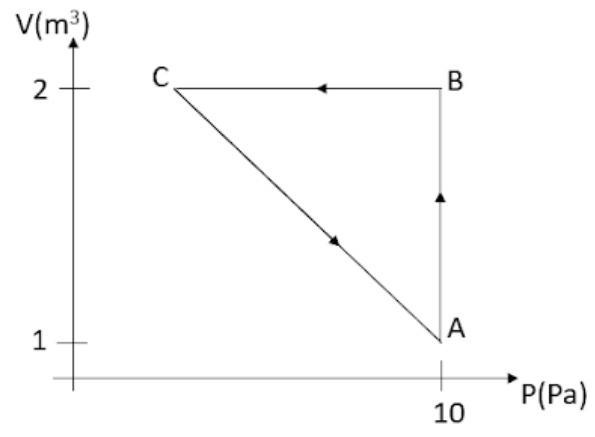Answer
425.4k+ views
Hint: From the given graph we can calculate work done for some of the processes. So, we will find the relation between the heat provided and work done by the gas. After that, we will find the work done in processes $A\to B$ and $B\to C$ and then subtract it from the total work done to find the work done by the gas in the process $C\to A$.
Formula used: $W=P\Delta V$
Complete step-by-step solution:
The change in internal energy for the cyclic process will be zero as the system comes back to state A and as internal energy is a state variable change in it will be zero. So in this case net heat provided to the gas will be equal to the work done by the gas. We will divide the cycle into three parts which are $A\to B$, $B\to C$, and $C\to A$. After that, we will find the work done for the processes for which it can be found using the given data. The total work done in the cycle will be the sum of all three processes. Let us first find the work done for the process $A\to B$
${{W}_{AB}}=P\Delta V$
The pressure remains the same for the whole process and the volume changes from 1 ${{m}^{3}}$ to 2 ${{m}^{3}}$.
So, ${{W}_{AB}}=10(2-1)=10$J.
Now for the process, $B\to C$, the work done here will be zero as only the pressure changes but the volume remains the same so no work will be done. ${{W}_{BC}}=0$
Now, we have that
${{W}_{AB}}+{{W}_{BC}}+{{W}_{CA}}=5$J
$10+0+{{W}_{CA}}=5\Rightarrow {{W}_{CA}}=5-10=-5$J.
Therefore, the work is done for the process $C\to A$ will be -5 J.
Hence, the correct option is A, i.e. -5 J.
Note: We must be careful in the sign convention when solving this question. It is asked how much work was done by the gas, as the volume of the gas decreases in the process $C\to A$, the work must have been done on the gas i.e. the work done by the gas must have been negative which is what we observe.
Formula used: $W=P\Delta V$
Complete step-by-step solution:
The change in internal energy for the cyclic process will be zero as the system comes back to state A and as internal energy is a state variable change in it will be zero. So in this case net heat provided to the gas will be equal to the work done by the gas. We will divide the cycle into three parts which are $A\to B$, $B\to C$, and $C\to A$. After that, we will find the work done for the processes for which it can be found using the given data. The total work done in the cycle will be the sum of all three processes. Let us first find the work done for the process $A\to B$
${{W}_{AB}}=P\Delta V$
The pressure remains the same for the whole process and the volume changes from 1 ${{m}^{3}}$ to 2 ${{m}^{3}}$.
So, ${{W}_{AB}}=10(2-1)=10$J.
Now for the process, $B\to C$, the work done here will be zero as only the pressure changes but the volume remains the same so no work will be done. ${{W}_{BC}}=0$
Now, we have that
${{W}_{AB}}+{{W}_{BC}}+{{W}_{CA}}=5$J
$10+0+{{W}_{CA}}=5\Rightarrow {{W}_{CA}}=5-10=-5$J.
Therefore, the work is done for the process $C\to A$ will be -5 J.
Hence, the correct option is A, i.e. -5 J.
Note: We must be careful in the sign convention when solving this question. It is asked how much work was done by the gas, as the volume of the gas decreases in the process $C\to A$, the work must have been done on the gas i.e. the work done by the gas must have been negative which is what we observe.
Recently Updated Pages
How many sigma and pi bonds are present in HCequiv class 11 chemistry CBSE

Why Are Noble Gases NonReactive class 11 chemistry CBSE

Let X and Y be the sets of all positive divisors of class 11 maths CBSE

Let x and y be 2 real numbers which satisfy the equations class 11 maths CBSE

Let x 4log 2sqrt 9k 1 + 7 and y dfrac132log 2sqrt5 class 11 maths CBSE

Let x22ax+b20 and x22bx+a20 be two equations Then the class 11 maths CBSE

Trending doubts
Fill the blanks with the suitable prepositions 1 The class 9 english CBSE

At which age domestication of animals started A Neolithic class 11 social science CBSE

Which are the Top 10 Largest Countries of the World?

Give 10 examples for herbs , shrubs , climbers , creepers

Difference between Prokaryotic cell and Eukaryotic class 11 biology CBSE

Difference Between Plant Cell and Animal Cell

Write a letter to the principal requesting him to grant class 10 english CBSE

Change the following sentences into negative and interrogative class 10 english CBSE

Fill in the blanks A 1 lakh ten thousand B 1 million class 9 maths CBSE




